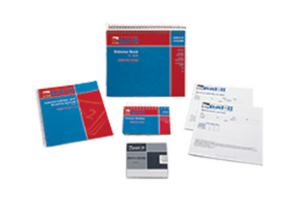Author:
Virginia Wise Berninger, PhD
Overview:
Diagnose dysgraphia, dyslexia, and oral and written language disability
Age Range:
K to 6
Administration:
Paper-and-pencil
Scoring Option:
Manual Scoring
Completion Time:
Varies depending on subtests selected by the examiner
Norms:
Scaled Scores and base rates
Publication Date:
2007
PAL-II Reading and Writing is a comprehensive, researched-based assessment system based on research funded by NICHD. PAL-II has applications at three tiers ranging from prevention to problem solving consultation to differential diagnosis. PAL-II Reading and Writing links to targeted evidenced-based interventions and lessons.
PAL-II Reading and Writing is the first nationally normed standardized test that can be used to diagnose dysgraphia, dyslexia, oral and written language disability (OWL LD).
PAL-II comes with a User Guide on CD that helps professionals in psychology, speech and language, education, and occupational therapy learn to use the PAL-II Reading and Writing. The interventions are included in the kit, and may be printed to use in the classroom.
Features & Benefits
- Easier to administer with the PAL-II User’s Guide
- Referral driven customization
- Recommends resources and types of interventions based on the assessment results
- Offers flexible administration—brief or comprehensive based on the referral needs
A link to the PAL–II User’s Guide is provided in your purchased kit so examiners can use it readily in their daily practice for multiple purposes, including:
- Reviewing the essentials of test administration prior to assessment
- Reviewing test interpretation prior to preparation of an assessment report
- Designing an early intervention program and progress monitoring plan in a specific academic domain
- Engaging in problem-solving consultation for specific reasons for referral
- Performing differential diagnosis and treatment planning for preparing an Individual Education Plan (IEP)
- Assists practitioners in assessment planning by guiding subtest selection through specific referral question(s)
- Guides the practitioner to research-based (and grade-based) interventions or lessons to improve student performance
- Explains the importance and specific construct measured by each subtest and how each construct affects the skill being measured
- Guides score interpretation
- Allows you to print unlimited quantities of the Summary Score Sheets and downloadable interventions and lessons
- Offers easy access to technical information such as development of the test, reliability studies, and validity studies
Pre-recorded Webinars
-
Educational Practice in Dyslexia: Professional Roles and Knowledge Gaps
Presenter: Tina Eichstadt and Adam Scheller
Overview
Five webinars about dyslexia held in 2016-2017 were attended by 6,591 SLPs, psychologists, and special educators. Webinar data offered insights into practitioners’ perspectives on dyslexia training needs and role clarification in practice settings. Presenters will discuss results, which suggests gaps between best practices in dyslexia and reports from individuals engaging in clinical practice.
Learner Outcomes
After the completion of the webinar, participants will be able to:
- List the two areas of dyslexia training practitioners request most often.
- Describe the knowledge gap identified by practitioners using scores for assessment and progress monitoring.
- Identify the role(s) practitioners currently play in inter-professional practice regarding dyslexia.
Time-ordered Agenda
1:00 to 1:05 pm – Introduction and overview
1:05 to 1:30 pm – Practitioner roles in dyslexia
1:30 to 1:55 pm – Practitioner knowledge and skills
1:55 to 2:00 pm – Conclusions and Wrap Up
This course is offered for 0.1 ASHA CEUs (Intermediate level, Professional area.)
Date: Feb 07, 2018
 PDF: Educational Practice in Dyslexia: Professional Roles and Knowledge Gaps
PDF: Educational Practice in Dyslexia: Professional Roles and Knowledge Gaps
 Video: Educational Practice in Dyslexia: Professional Roles and Knowledge Gaps
Video: Educational Practice in Dyslexia: Professional Roles and Knowledge Gaps
-
PAL-II: Overview of the Process Assessment of the Learner-Second Edition
Presenter: Gloria Maccow, PhD
PAL-II Reading and Writing and PAL-II Math are comprehensive, research-based assessment systems. The instruments can be used at three tiers ranging from prevention to problem solving consultation to differential diagnosis. PAL-II Reading and Writing links to targeted evidence-based interventions and lessons. During this 1-hour webinar, participants will learn about the three-tiered approach to assessment described by Dr. Virginia Berninger, author of the PAL-II. The presenter will describe how the components of the PAL-II are used to prevent academic problems and to identify targeted interventions for struggling students.
Date: Nov 15, 2011


-
PAL-II Advanced: Tiered Assessment and Intervention
Presenter: Amy Dilworth Gabel, PhD
PAL-II Reading and Writing and PAL-II Math are comprehensive, research-based assessment systems. The instruments can be used at three tiers ranging from prevention to problem solving consultation to differential diagnosis. PAL-II Reading and Writing links to targeted evidence-based interventions and lessons. During this webinar, participants will learn about the three-tiered approach to assessment described by Dr. Virginia Berninger, author of the PAL-II. The presenter will describe how the components of the PAL-II are used to prevent academic problems and to identify targeted interventions for struggling students. As a result of this presentation, participants will
- Describe the reading, writing, and math skills students are expected to master at specified grade levels;
- Discuss the cognitive processes that are critical to acquisition of reading, writing, and math skills;
- Describe how to choose an intervention based on analysis of a student’s performance of a skill and mastery of the cognitive processes needed to perform the skill.
Date: Dec 02, 2010









